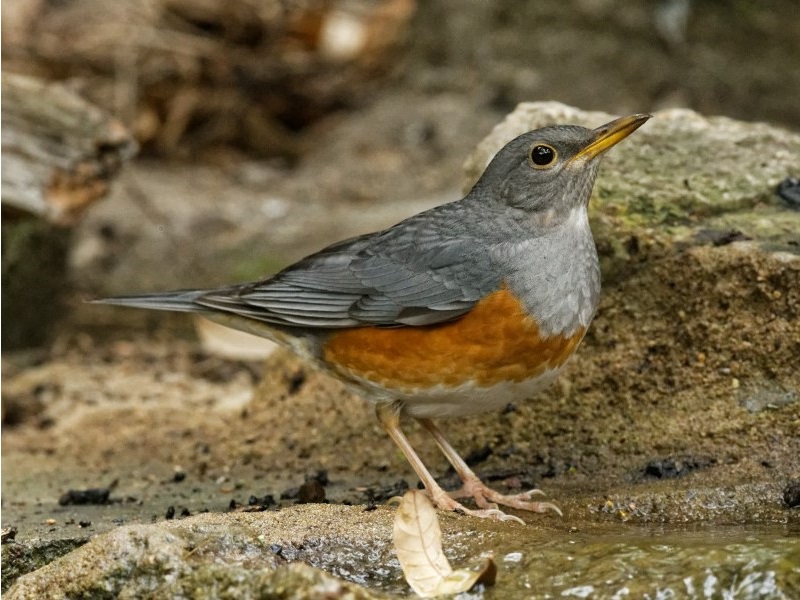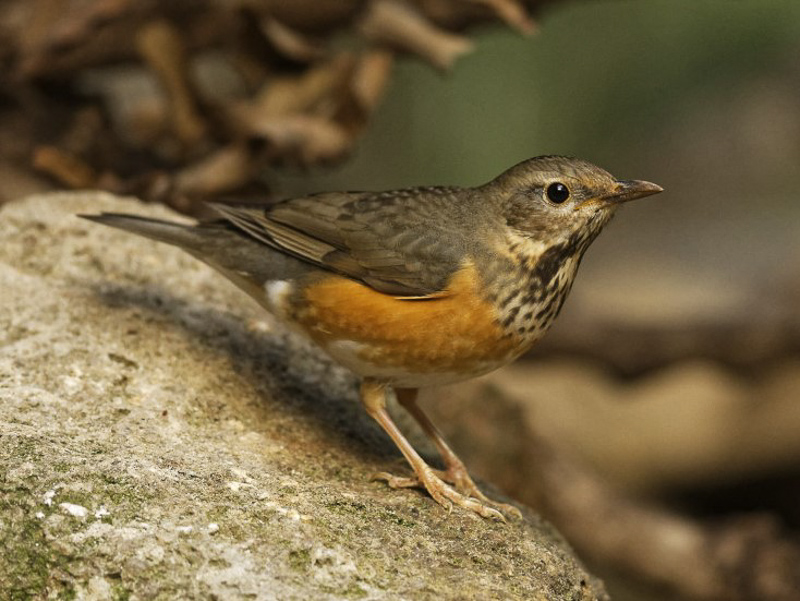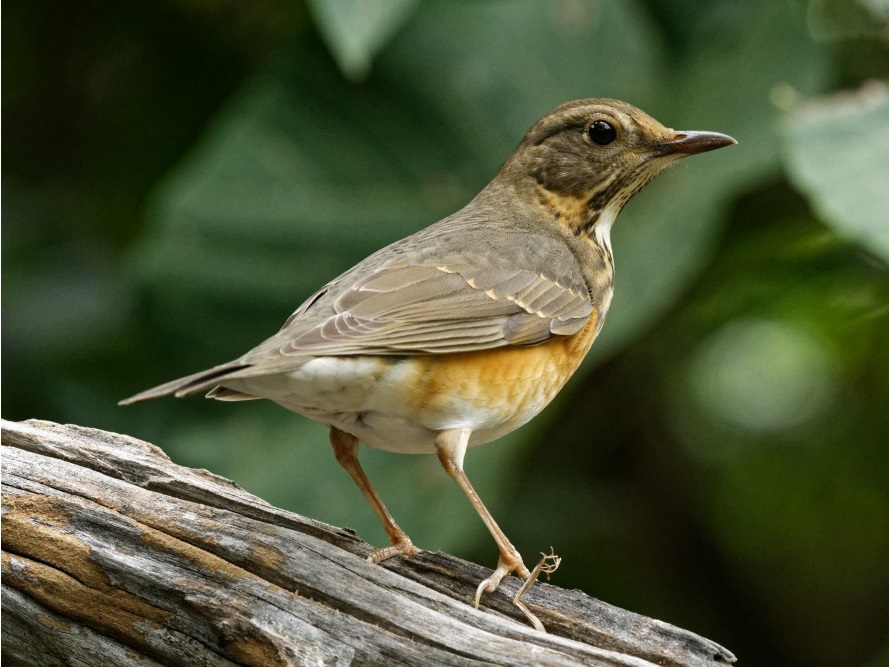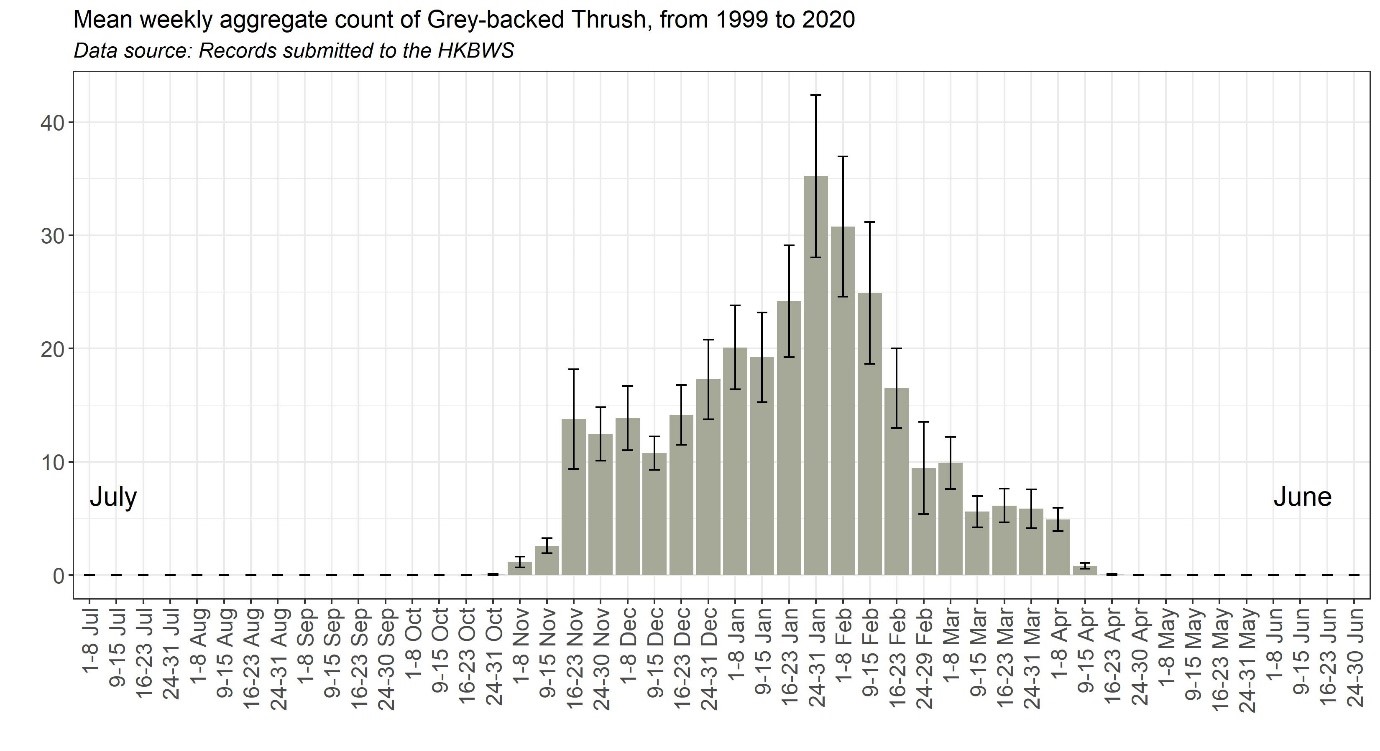Grey-backed Thrush Turdus hortulorum 灰背鶇
Category I. Common winter visitor and uncommon passage migrant to diverse wooded areas.
IDENTIFICATION

Jan. 2020, Guy Miller. Adult male.
20-23 cm. One of the two commonest Turdus thrushes in HK. Adult male has medium grey upperparts, head, throat and chest, orange narrowly below chest and broadly along flanks, white belly, vent and undertail coverts. Bill largely yellowish.

Dec. 2017, Guy Miller. First-winter male.
First-winter male similar but grey infused by brown, chest and upper belly has dark spots, usually some greater coverts are tipped pale, bill duller.

Dec. 2017, Guy Miller. Adult female.
Adult female is brown above, greyer on rump and uppertail coverts, with coarse brown spots on off-white chest and throat and orange mid to lower flanks. Greater coverts are plain brown.

Nov. 2019, Guy Miller. First-winter female.
First-winter females are dull brown above and have pale tips to greater coverts visible for much of the winter and more extensive dark spotting.
VOCALISATIONS
The high-pitched sibilant slightly buzzing flight calls of this and other Turdus thrushes are a distinctive feature of woodlands in winter. Distinguishing the calls of different species is difficult. However, the typical flight call tends to be slightly higher in pitch than that of Japanese Thrush.
Alarm calls are extremely similar across Turdus thrushes in HK.
DISTRIBUTION & HABITAT PREFERENCE
Occurs in a diverse array of wooded habitats throughout HK, including forests, fung shui woodland, and more open, lightly-wooded country including gardens and urban parks. Closed-canopy secondary forest would appear to be the preferred habitat.
Recorded in 20.9% of 1km squares in the winter bird atlas of 2001-05, this declined to 14.1% in the 2016-19 survey, indicating that the species is now less widespread than formerly. Declines appear to have occurred in southern Lantau, HK Island, Sai Kung and northeast New Territories. As HK lies at the southern edge of its wintering range, it is possible that milder winters arising from climate change allow some birds to remain further north in the non-breeding season.
OCCURRENCE
The core wintering period appears to be from the third week of November to the third week of February (Figure 1). The earliest autumn record occurred on 31 October 2019, though numbers remain low in the first half of November with little evidence of autumn passage. After the February departure of many birds, numbers remain low but similar until the first week of April, but there are few records subsequently. At least some of the March and April records appear to involve passage migrants. The latest spring record occurred on 25 April 1978.
Grey-backed Thrushes are frequently seen in small parties, usually of up to 20 birds. In forest habitats they are frequently seen with Japanese Thrush. Numbers can be difficult to judge accurately as they tend to be shy and elusive in woodland, with only the distinctive high-pitched sibilant calls indicating their presence.
Highest numbers are recorded after surges of the northeast monsoon, partly due no doubt to birds being more obvious as they are reluctant to cease foraging and fly away. However, the cold weather also causes genuine influxes of birds such as 50 in Tai Po Kau and 42 at Kadoorie FBG on 18 and 21 January 1992 respectively, and 100 thrushes at Aberdeen CP on 2 February 1995 mostly of this species. Ringing data from Kadoorie ARC and Mai Po indicates that birds may return to the same site in successive seasons.
Swinhoe (1861) recorded what appears to be this species as abundant in Macau. Subsequent authors (Kershaw 1904, Vaughan and Jones 1913 and Herklots 1953) all noted it to be a common winter visitor, from mid-November to early May.
BEHAVIOUR, FORAGING & DIET
Frequently seen at fruiting trees and shrubs, including Melia azedarach, Mallotus paniculatus, Ilex rotunda var. microcarpa, Machilus thunbergi, Photinia benthaminiana, Schlefflera heptaphylla, Ficus superba, Pavetta hongkongensis, Osmanthus matsumuranus, Syzygium hancei, Psychotria asiatica and Celtis sinensis. Also forages in leaf litter for invertebrates, apparently more so early morning and evening.
Flights of Turdus thrushes from overnight roosting sites to foraging areas are a feature of wooded areas. Very early morning and at dusk birds can be seen at the edge of forest paths foraging in leaf litter.
RANGE & SYSTEMATICS
Monotypic. Breeds in southeast Siberia, far northeast China and North Korea, and winters in south China and north Vietnam (Collar and de Juana 2020). In China breeds in northeast and winters south of the Chang Jiang (Yangtze River) (Liu and Chen 2020).
CONSERVATION STATUS
IUCN: Least Concern. Population trend unknown.
Figure 1.

Collar, N. and E. de Juana (2020). Grey-backed Thrush (Turdus hortulorum), version 1.0. In Birds of the World (J. del Hoyo, A. Elliott, J. Sargatal, D. A. Christie, and E. de Juana, Editors). Cornell Lab of Ornithology, Ithaca, NY, USA. https://doi.org/10.2173/bow.gybthr1.01
Herklots, G. A. C. (1953). Hong Kong Birds. South China Morning Post, Hong Kong.
Kershaw. J. C. (1904). List of birds of the Quangtung Coast, China. Ibis 1904: 235-248.
Liu, Y. and Y. H. Chen (eds) (2020). The CNG Field Guide to the Birds of China (in Chinese). Hunan Science and Technology Publication House, Changsha.
Swinhoe, R. (1861). Notes on the ornithology of Hong Kong, Macao and Canton, made during the latter end of February, March, April and the beginning of May 1860. Ibis 1861: 23-57.
Vaughan, R. E. and K. H. Jones (1913). The birds of Hong Kong, Macao and the West River or Si Kiang in South-East China, with special reference to their nidification and seasonal movements. Ibis 1913: 17-76, 163-201, 351-384.

